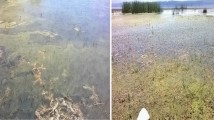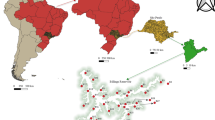Abstract
Physico-chemical parameters, hydrological conditions, and microbial interactions can affect the growth and persistence of cyanobacteria, but the interacting effects among these bloom-forming factors are still poorly known. This hampers our capacity to predict the occurrence of cyanobacterial bloom accurately. Here, we studied the relationship between temperature, N and P cycles, and the microbial community abundance and diversity at 0.5 m under the surface of West Lake (China) from January 21 to November 20, 2015, in order to better understand the key factors regulating temporal changes in the cyanobacterial community. Using high throughput sequencing of the 16S rRNA gene V3-V4 region, we studied the diversity and abundance of bacteria. In parallel, we measured physico-chemical parameters and followed the abundance of key genes involved in N fixation, denitrification, and nutrient uptake. Multivariate analyses suggest that P concentration and water temperature are the key factors controlling the outbreak of summer cyanobacterial bloom. RT-qPCR analyses of the bacterial community and measurements of the copy number of denitrification-related gene (nirK, nosZ, nirS) show that denitrification potential and denitrifying bacteria relative abundance (Pseudomonas and Bacillus) increased in concert with diazotrophic cyanobacterial genera (Anabaena, Nostoc, Aphanizomenon flos-aquae) and the common bloom-forming non-diazotrophic cyanobacterium genus Microcystis. The present study brings new insights on the complex interplay between physico-chemical parameters, heterotrophic bacterial community composition, nitrogen cycle, and cyanobacteria dominance in a eutrophic lake.








Similar content being viewed by others
References
Adams HE, Crump BC, Kling GW (2010) Temperature controls on aquatic bacterial production and community dynamics in arctic lakes and streams. Environ Microbiol 12:1319–1333
Bentzon-Tilia M, Traving SJ, Mantikci M, Knudsen-Leerbeck H, Hansen JL, Markager S, Riemann L (2014) Significant N2 fixation by heterotrophs, photoheterotrophs and heterocystous cyanobacteria in two temperate estuaries. ISME J 9:273–285
Berdjeb L, Pollet T, Chardon C, Jacquet S (2013) Spatio-temporal changes in the structure of archaeal communities in two deep freshwater lakes. FEMS Microbiol Ecol 86:215–230
Beversdorf LJ, Miller TR, McMahon KD (2013) The role of nitrogen fixation in cyanobacterial bloom toxicity in a temperate, eutrophic lake. PLoS One 8:e56103
Bouwman AF, Boumans LJM, Batjes NH (2002) Emissions of N2O and NO from fertilized fields: summary of available measurement data. Global Biogeochem Cycle 16:1058–1071
Braker G, Fesefeldt A, Witzel KP (1998) Development of PCR primer systems for amplification of nitrite reductase genes (nirK and nirS) to detect denitrifying bacteria in environmental samples. Appl Environ Microbiol 64:3769–3775
Brookes JD, Carey CC (2011) Resilience to blooms. Science 333:46–47
Cai H, Jiang H, Krumholz LR, Yang Z (2014) Bacterial community composition of size-fractioned aggregates within the phycosphere of cyanobacterial blooms in a eutrophic freshwater lake. PLoS One 9:e102879
Cai HY, Yan ZS, Wang AJ, Krumholz LR, Jiang HL (2013) Analysis of the attached microbial community on mucilaginous cyanobacterial aggregates in the eutrophic Lake Taihu reveals the importance of Planctomycetes. Microb Ecol 66:73–83
Caporaso JG, Kuczynski J, Stombaugh J, Bittinger K, Bushman FD (2010) QIIME allows analysis of high-throughput community sequencing data. Nat Methods 7:335–336
Conrad R (1996) Soil microorganisms as controllers of atmospheric trace gases (H2, CO, CH4, OCS, N2O, and NO). Microbiol Rev 60:609–640
Dai R, Liu H, Qu J, Hou Y, Zhao X (2009) Effects of amino acids on microcystin production of the Microcystis aeruginosa. J Hazard Mater 161:730–736
Duan HT, Ma RH, Xu XF, Kong FX, Zhang SX, Kong WJ, Hao JY, Shang LL (2009) Two-decade reconstruction of algal blooms in China’s Lake Taihu. Environ Sci Technol 43:3522–3528
Duarte S, Fernandes I, Nogueira MJ, Cássio F, Pascoal C (2013) Temperature alters interspecific relationships among aquatic fungi. Fungal Ecol 6:187–191
Fadrosh DW, Ma B, Gajer P, Sengamalay N, Ott S, Brotman RM, Ravel J (2014) An improved dual-indexing approach for multiplexed 16S rRNA gene sequencing on the Illumina MiSeq platform. Microbiome 2:6
Fuhrman JA, Steele JA, Hewson I, Schwalbach MS, Brown MV, Green JL, Brown JH (2008) A latitudinal diversity gradient in planktonic marine bacteria. Proc Natl Acad Sci U S A 105:7774–7778
Huang ZT, Xie B, Yuan Q, Xu WQ, Lu J (2014) Microbial community study in newly established Qingcaosha Reservoir of Shanghai, China. Appl Microbiol Biotechnol 98:9849–9858
Huber V, Wagner C, Gerten D, Adrian R (2012) To bloom or not to bloom: contrasting responses of cyanobacteria to recent heat waves explained by critical thresholds of abiotic drivers. Oecologia 169:245–256
Hunter PD, Tyler AN, Gilvear DJ, Willby NJ (2009) Using remote sensing to aid the assessment of human health risks from blooms of potentially toxic cyanobacteria. Environ Sci Technol 43:2627–2633
Jin ZF, Qin X, Chen LX, Jin MT, Li FL (2015) Using dual isotopes to evaluate sources and transformations of nitrate in the West Lake watershed, eastern China. J Contam Hydrol 177:64–75
Leflaive J, Ten-Hage L (2007) Algal and cyanobacterial secondary metabolites in freshwaters: a comparison of allelopathic compounds and toxins. Freshw Biol 52:199–214
Lewis WM, Wurtsbaugh WA, Paerl HW (2011) Rationale for control of anthropogenic nitrogen and phosphorus to reduce eutrophication of inland waters. Environ Sci Technol 45:10300–10305
O’Neil JM, Davis TW, Burford MA, Gobler CJ (2012) The rise of harmful cyanobacteria blooms: the potential roles of eutrophication and climate change. Harmful Algae 14:313–334
Ogilvie BG, Rutter M, Nedwell DB (1997) Selection by temperature of nitrate-reducing bacteria from estuarine sediments: species composition and competition for nitrate. FEMS Microbiol Ecol 23:11–22
Otten TG, Xu H, Qin B, Zhu G, Paerl HW (2012) Spatiotemporal patterns and ecophysiology of toxigenic microcystis blooms in Lake Taihu, China: implications for water quality management. Environ Sci Technol 46:3480–3488
Paerl HW (2008) Nutrient and other environmental controls of harmful cyanobacterial blooms along the freshwater marine continuum. Adv Exp Med Biol 619:216–237
Paerl HW (2009) Controlling eutrophication along the freshwater marine continuum: dual nutrient (N and P) reductions are essential. Estuar Coast 32:593–601
Paerl HW, Paul VJ (2012) Climate change: links to global expansion of harmful cyanobacteria. Water Res 46:1349–1363
Paerl HW, Xu H, Hall NS, Zhu G, Qin B, Wu Y, Rossignol KL, Dong L, McCarthy MJ, Joyner AR (2014) Controlling cyanobacterial blooms in hypertrophic Lake Taihu, China: will nitrogen reductions cause replacement of non-N2 fixing by N2 fixing taxa? PLoS One 9:113–123
Pomeroy LR, Wiebe WJ (2001) Temperature and substratesas interactive limiting factors for marine heterotrophic bacteria. Aquat Microb Ecol 23:187–204
Qian HF, Lu T, Peng XF, Han X, Fu ZW, Liu WP (2011) Enantioselective phytotoxicity of the herbicide imazethapyr on the response of the antioxidant system and starch metabolism in Arabidopsis thaliana. PLoS One 6:e19451
Qian HF, Pan XJ, Chen J, Zhou DM, Chen ZG, Zhang L, Fu ZW (2012) Analyses of gene expression and physiological changes in Microcystis aeruginosa reveal the phytotoxicities of three environmental pollutants. Ecotoxicology 21:847–859
Qin HP, Su Q, Khu ST (2013) Assessment of environmental improvement measures using a novel integrated model: a case study of the Shenzhen River catchment, China. J Environ Manag 114:486–495
Rigosi A, Carey CC, Ibelings BW, Brookes JD (2014) The interaction between climate warming and eutrophication to promote cyanobacteria is dependent on trophic state and varies among taxa. Limnol Oceanogr 59:99–114
Rigosi A, Hanson P, Hamilton DP, Hipsey M, Rusak JA, Bois J, Sparber K, Chorus I, Watkinson AJ, Qin B, Kim B, Brookes JD (2015) Determining the probability of cyanobacterial blooms: the application of Bayesian networks in multiple lake systems. Ecol Appl 25:186–199
Schindler DW, Hecky RE, Findlay DL, Stainton MP, Parker BR, Paterson MJ, Beaty KG, Lyng M (2008) Eutrophication of lakes cannot be controlled by reducing nitrogen input: results of a 37-year whole-ecosystem experiment. Proc Natl Acad Sci U S A 105:11254–11258
Schindler DW (1977) Evolution of phosphorus limitation in lakes: natural mechanisms compensate for deficiencies of nitrogen and carbon in eutrophied lakes. Science 195:260–262
Shi L, Cai Y, Li P, Yang H, Liu Z, Kong L, Yu Y, Kong F (2009) Molecular identification of the colony-associated cultivable bacteria of the cyanobacterium Microcystis aeruginosa and their effects on algal growth. J Freshw Ecol 24:211–218
Shi T, Ilikchyan I, Rabouille S, Zehr JP (2010) Genome-wide analysis of diel gene expression in the unicellular N2-fixing cyanobacterium Crocosphaera watsonii WH 8501. ISME J 4:621–632
Smith VH, Tilman GD, Nekola JC (1999) Eutrophication: impacts of excess nutrient inputs on freshwater, marine, and terrestrial ecosystems. Environ Pollut 100:179–196
Sun CC, Jin YJ, He HF, Wang W, He HW, Fu ZW, Qian HF (2015) Two novel herbicide candidates affect Arabidopsis thaliana growth by inhibiting nitrogen and phosphate absorption. Pestic Biochem Physiol 123:1–8
Tan X, Kong FX, Cao HS, Yu Y, Zhang M (2008) Recruitment of bloom-forming cyanobacteria and its driving factors. Afr J Biotechnol 7:4726–4731
Tang CJ, Zheng P, Zhang L, Chen JW, Mahmood Q, Chen XG, Hu BL, Wang CH, Yu Y (2010) Enrichment features of anammox consortia from methanogenic granules loaded with high organic and methanol contents. Chemosphere 79:613–619
Tison DL, Pope DH, Boylen CW (1980) Influence of seasonal temperature on the temperature optima of bacteria in sediments of Lake George. New-York Appl Environ Microbiol 39:675–677
Torrey MS, Lee GF (1975) Nitrogen fixation in Lake Mendota, Madison. Wisconsin Limnol Oceanogr 21:365–378
Wei W, Isobe K, Nishizawa T (2015) Higher diversity and abundance of denitrifying microorganisms in environments than considered previously. ISME J 9:1954–1965
Xu H, Paerl HW, Qin B, Zhu G, Hall NS, Wu Y (2015) Determining critical nutrient thresholds needed to control harmful cyanobacterial blooms in eutrophic Lake Taihu, China. Environ Sci Technol 49:1051–1059
Zhang J, Yang Y, Zhao L, Li Y, Xie S, Liu Y (2015) Distribution of sediment bacterial and archaeal communities in plateau freshwater lakes. Appl Microbiol Biotechnol 99:3291–3302
Zumft WG (1997) Cell biology and molecular basis of denitrification. Microbiol Mol Biol Rev 61:533–616
Acknowledgements
This work was financially supported by the Natural Science Foundation of China (21277127, 21577128), Zhejiang Provincial Natural Science Foundation of China (LR14B070001), and Program for Changjiang Scholars and Innovative Research Team in University (IRT13096).
Author information
Authors and Affiliations
Corresponding author
Ethics declarations
Conflict of interest
The authors declare that they have no conflict of interest.
Ethical approval
This article does not contain any experiments involving human participants or animals performed by any of the authors. Informed consent was obtained from all individual participants included in the study.
Rights and permissions
About this article
Cite this article
Song, H., Xu, J., Lavoie, M. et al. Biological and chemical factors driving the temporal distribution of cyanobacteria and heterotrophic bacteria in a eutrophic lake (West Lake, China). Appl Microbiol Biotechnol 101, 1685–1696 (2017). https://doi.org/10.1007/s00253-016-7968-8
Received:
Revised:
Accepted:
Published:
Issue Date:
DOI: https://doi.org/10.1007/s00253-016-7968-8




